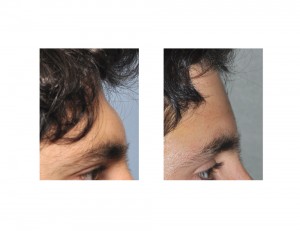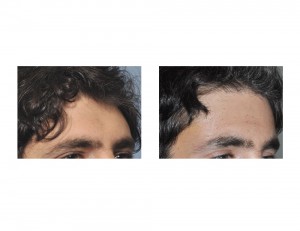Background: The forehead represents one third of the face and had a valuable role to play in facial aesthetics. Besides the length and width of the forehead, its other major aesthetic feature is its slope. (as most easily appreciated in the side view) This forehead feature is well known to be gender specific. Women have more vertical inclined forehead (with convexity) and a smooth transition into the brow bones. Conversely men have a more inclined forehead with defined brow bones and a definitive break between the brow bones and the forehead.
Most men that desire forehead changes have issues with either the prominence of the brow bones or shape of the forehead above it. While both may be at fault, isolated forehead concerns are usually because of lack of projection. The forehead slopes back too far. The more retroclined the forehead slope is, the more unaesthetic it becomes as it creates more of a ‘neanderthal’ appearance by making the brow bones bigger.
Male forehead augmentation can be successfully done through two methods of bone augmentation. Options include the application of a bone cement (like PMMA) or the preoperative fabrication of a custom designed silicone implant. Each method has its own distinct advantages and disadvantages but both can be very effective. PMMA cement application requires an artistic sense to apply it evenly without over correction or palpable temporal edges.
Case Study: This 35 year-old male wanted to improve the shape of his forehead as he felt it had too much of a backward slope to it. It had a near 55 degree angulation and he wanted it almost vertical in a profile view.


The historic method of forehead augmentation with PMMA bone cement is still an effective treatment approach. Its biggest drawback is that it must be intraoperatively shaped and this introduces the variable of irregularities or shape issues. Considerable experience is needed in working with bone cements in their putty phase to master their handling and shaping.
Case Highlights:
1) Forehead augmentation in men is usually done to correct a severely backward sloping forehead which accentuates the size of the brow bones.
2) One method of forehead augmentation is the application of bone cement through an open scalp incision.
3) The shape of a male forehead augmentation is to change the slope of the forehead but to still preserve a brow bone break.
Dr. Barry Eppley
Indianapolis, Indiana


